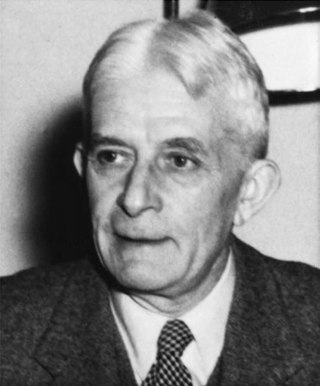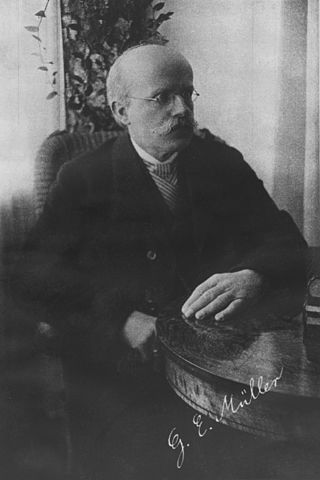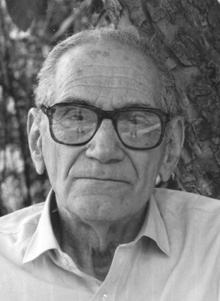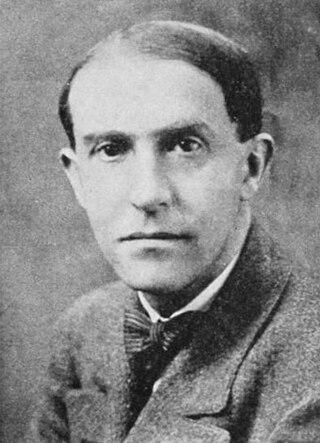Related Research Articles
Gestalt psychology, gestaltism, or configurationism is a school of psychology and a theory of perception that emphasises the processing of entire patterns and configurations, and not merely individual components. It emerged in the early twentieth century in Austria and Germany as a rejection of basic principles of Wilhelm Wundt's and Edward Titchener's elementalist and structuralist psychology.

Color constancy is an example of subjective constancy and a feature of the human color perception system which ensures that the perceived color of objects remains relatively constant under varying illumination conditions. A green apple for instance looks green to us at midday, when the main illumination is white sunlight, and also at sunset, when the main illumination is red. This helps us identify objects.

Wolfgang Köhler was a German psychologist and phenomenologist who, like Max Wertheimer and Kurt Koffka, contributed to the creation of Gestalt psychology.
Experimental psychology refers to work done by those who apply experimental methods to psychological study and the underlying processes. Experimental psychologists employ human participants and animal subjects to study a great many topics, including sensation, perception, memory, cognition, learning, motivation, emotion; developmental processes, social psychology, and the neural substrates of all of these.
Psychophysics quantitatively investigates the relationship between physical stimuli and the sensations and perceptions they produce. Psychophysics has been described as "the scientific study of the relation between stimulus and sensation" or, more completely, as "the analysis of perceptual processes by studying the effect on a subject's experience or behaviour of systematically varying the properties of a stimulus along one or more physical dimensions".
Gestalt Theoretical Psychotherapy(GTP) is a method of psychotherapy based strictly on Gestalt psychology. Its origins go back to the 1920s when Gestalt psychology founder Max Wertheimer, Kurt Lewin and their colleagues and students started to apply the holistic and systems theoretical Gestalt psychology concepts in the field of psychopathology and clinical psychology. Through holism, "a person's thinking, feeling, actions, perceptions, attitudes and logical operations" are seen as one unity. Many developments in psychotherapy in the following decades drew from these early beginnings, like e.g. group psychoanalysis (S. Foulkes), Gestalt therapy (Laura Perls, Fritz Perls, Goodman, and others), or Katathym-imaginative Psychotherapy (Hanscarl Leuner).
James Jerome Gibson was an American psychologist and is considered to be one of the most important contributors to the field of visual perception. Gibson challenged the idea that the nervous system actively constructs conscious visual perception, and instead promoted ecological psychology, in which the mind directly perceives environmental stimuli without additional cognitive construction or processing. A Review of General Psychology survey, published in 2002, ranked him as the 88th most cited psychologist of the 20th century, tied with John Garcia, David Rumelhart, Louis Leon Thurstone, Margaret Floy Washburn, and Robert S. Woodworth.
Mathematical psychology is an approach to psychological research that is based on mathematical modeling of perceptual, thought, cognitive and motor processes, and on the establishment of law-like rules that relate quantifiable stimulus characteristics with quantifiable behavior. The mathematical approach is used with the goal of deriving hypotheses that are more exact and thus yield stricter empirical validations. There are five major research areas in mathematical psychology: learning and memory, perception and psychophysics, choice and decision-making, language and thinking, and measurement and scaling.

Edwin Ray Guthrie was a behavioral psychologist who began his career as a mathematics teacher and philosopher. But, he became a psychologist at the age of 33. He spent most of his career at the University of Washington, where he became a full professor and then an emeritus professor in psychology.
Quantitative psychology is a field of scientific study that focuses on the mathematical modeling, research design and methodology, and statistical analysis of psychological processes. It includes tests and other devices for measuring cognitive abilities. Quantitative psychologists develop and analyze a wide variety of research methods, including those of psychometrics, a field concerned with the theory and technique of psychological measurement.

Georg Elias Müller was a significant early German experimental psychologist who is credited with the theory of retroactive interference.
Structuralism in psychology is a theory of consciousness developed by Edward Bradford Titchener. This theory was challenged in the 20th century.
Scholar, educator, and philanthropist Herschel Leibowitz is widely recognized for his research in visual perception and for his symbiotic approach to conducting research that both advanced theory and helped in the understanding and relief of societal problems. His research on transportation safety included studies of nearsightedness during night driving, vision during civil twilight, an illusion that underlies the behavior of motorists involved in auto-train collisions, susceptibility of pilots to illusions caused by visual-vestibular interactions, and the design of aircraft instrument panels.

Jean-Claude Falmagne is a mathematical psychologist whose scientific contributions deal with problems in reaction time theory, psychophysics, philosophy of science, measurement theory, decision theory, and educational technology. Together with Jean-Paul Doignon, he developed knowledge space theory, which is the mathematical foundation for the ALEKS software for the assessment of knowledge in various academic subjects, including K-12 mathematics, chemistry, and accounting.

Chingis A. Izmailov was a Russian psychophysiologist and psychophysicist, the principal author of the spherical model of color space.

Hans Wallach was a German-American experimental psychologist whose research focused on perception and learning. Although he was trained in the Gestalt psychology tradition, much of his later work explored the adaptability of perceptual systems based on the perceiver's experience, whereas most Gestalt theorists emphasized inherent qualities of stimuli and downplayed the role of experience. Wallach's studies of achromatic surface color laid the groundwork for subsequent theories of lightness constancy, and his work on sound localization elucidated the perceptual processing that underlies stereophonic sound. He was a member of the National Academy of Sciences, a Guggenheim Fellow, and recipient of the Howard Crosby Warren Medal of the Society of Experimental Psychologists.
The range–frequency compromise in judgment is a theory in cognitive psychology developed by Allen Parducci in the mid-1960s. Range–frequency is descriptive of how judgments reflect a compromise between a range principle that assigns each category to an equal subrange of contextual stimuli and a frequency principle that assigns each of the categories to the same number of contextual stimuli. Each judgment is a weighted average of what it would have been judged were it to follow just the range or just the frequency principle. A crucial deduction from the theory is that the mean of all judgments is proportionate to the skew of the frequency distribution of the context under which the judgment is made, assuming that the context is an unbiased representation of the stimuli that are judged.

Russell L. De Valois was an American scientist recognized for his pioneering research on spatial and color vision.

Mary Henle was an American psychologist who's known most notably for her contributions to Gestalt Psychology and for her involvement in the American Psychological Association. Henle also taught at the New School of Social Research in New York; she was involved in the writing of eight book publications and also helped develop the first psychology laboratory manual in 1948 based on the famous works of Kurt Lewin.

Kurt Koffka was a German psychologist and professor. He was born and educated in Berlin, Germany; he died in Northampton, Massachusetts, from coronary thrombosis. He was influenced by his maternal uncle, a biologist, to pursue science. He had many interests including visual perception, brain damage, sound localization, developmental psychology, and experimental psychology. He worked alongside Max Wertheimer and Wolfgang Köhler to develop Gestalt psychology. Koffka had several publications including "The Growth of the Mind: An Introduction to Child Psychology" (1924) and "The Principles of Gestalt Psychology" (1935) which elaborated on his research.
References
- ↑ Agnes N. O'Connell; Nancy Felipe Russo (18 March 2014). Models of Achievement: Reflections of Eminent Women in Psychology. Taylor & Francis. pp. 159–. ISBN 978-1-317-78589-7.
- ↑ Hall, Granville Stanley; Titchener, Edward Bradford; Dallenbach, Karl M.; Bentley, Madison; Boring, Edwin Garrigues; Washburn, Margaret Floy (1979). The American Journal of Psychology. Vol. 92. p. 153.
- 1 2 Helson, H. (1967). Harry Helson. In E. G. Boring D. Lindzey (Eds.), A history of psychology in autobiography (pp. 193-220). New York: Appleton-Century-Crofts.
- ↑ William Poundstone (9 January 2011). Priceless: The Hidden Psychology of Value. Oneworld Publications. pp. 36–. ISBN 978-1-78074-033-1.
- 1 2 Bevan, W. (1979). Harry Helson: 1898-1977. The American Journal of Psychology, 92(1), 153-160.
- ↑ William R. Uttal (27 June 2014). A Taxonomy of Visual Processes. Psychology Press. pp. 84–. ISBN 978-1-317-66895-4.
- ↑ Adaptation-Level Theory. In Oxford Reference. Retrieved from http://www.oxfordreference.com/view/10.1093/oi/authority.20110803095350211.
- ↑ Hasan M. El-Shamy (1999). Tales Arab Women Tell and the Behavioral Patterns They Portray. Indiana University Press. pp. 56–. ISBN 0-253-33529-9.
- ↑ Masin, S. C. (1999). Harry Helson, what did you do? In P. R. Killeen & W. R. Uttal (Eds.), Proceedings of the fifteenth annual meeting of the International Society for Psychophysics, Tempe, AZ: International Society for Psychophysics (pp. 302-307).
- ↑ Jon E. Roeckelein (1998). Dictionary of Theories, Laws, and Concepts in Psychology. Greenwood Publishing Group. pp. 231–. ISBN 978-0-313-30460-6.
- ↑ The Harry Helson Award. Retrieved from: https://www.k-state.edu/psych/graduate/graduate_Helson_Award.htm Archived 2015-03-09 at the Wayback Machine